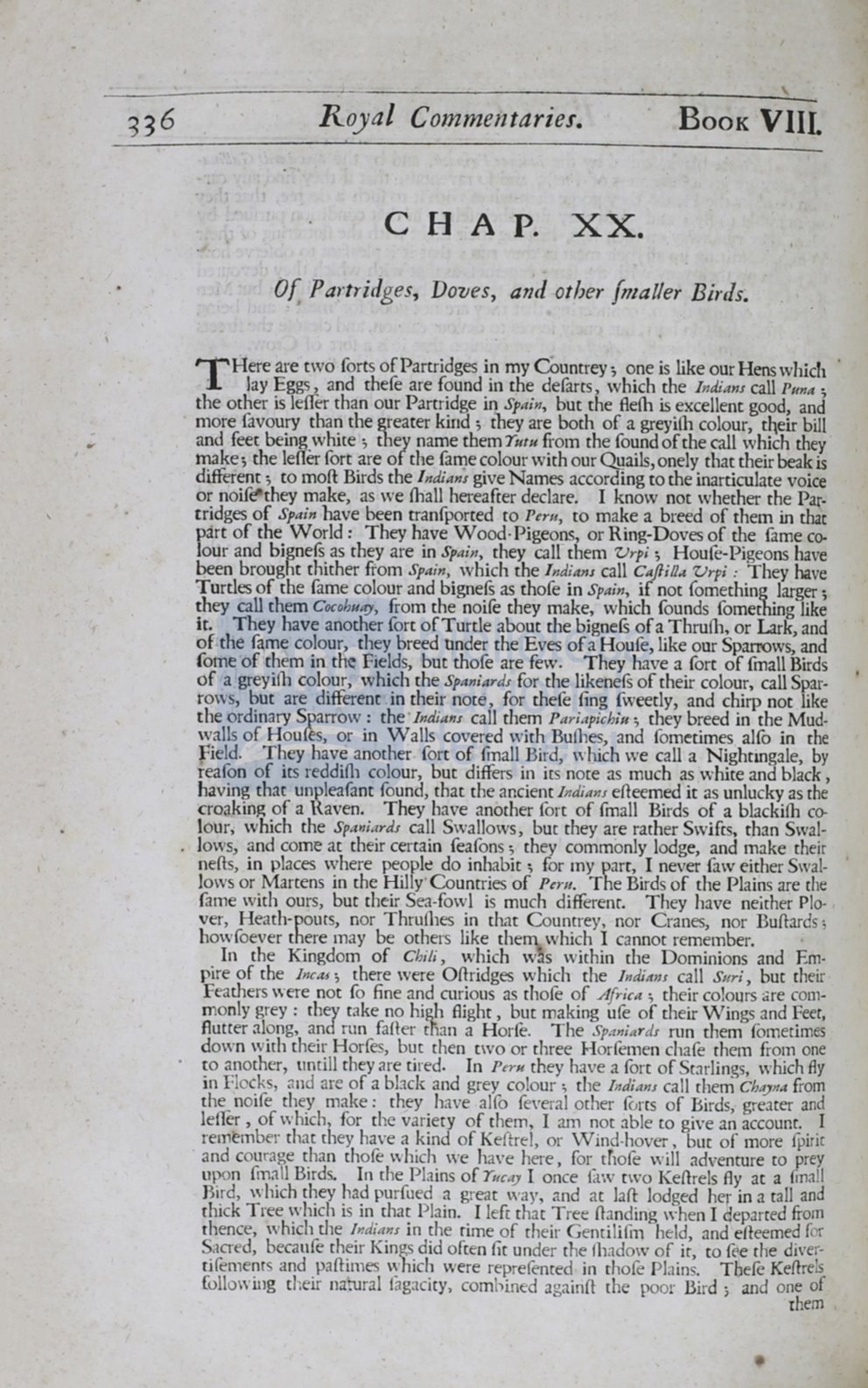

..
Royal
Commentaries.
BooK
VIII.
CH
AP.
xx.
Of
Partridges, Doves, and
other f111aUer
Birds.
T
Here are two forts ofPartridges in my Countrey; one is like our Hens
which ·
lay
Eggs, and thefe are found
in
the defarrs, which the
Indians
call
Puna
;
the other
is
leffer than our Partridge
in
Spain,
but the flefh
is
excellent good, and
more favoury than the greater kind; they are both of
a
greyi(h
colour, tqeir
bill
and feet being_white ; they name them
Tutu
from the found of the
call
which
they
make; the lefler fort are of the fame colour with our
QJails,
onely that their
beak
is
different ; to moft Birds the
Indians
give Names according to the inarticulate voice
or noifc they make, as we fhall hereafter declare.
I
know not whether the Par–
tridges of
Spain
bave been tranfported to
Peru,
to
make a breed of them
in
that
part of the World
:
They have Wood· Pigeons, or Ring-Doves of the fame
co–
lour and bignefs as they are
in
Spain,
they
calr
them
Vrpi
;
Houfe-Pigeons have
been brought thither from
Spain,
which the
Indians
call
CaftiO.i Vrpi:
They have
Turtles of the fame colour and bignefs as thofe in
Spain,
if
not fomething larger ;
they
call
them
Cocohu~,
from the noife they make, which founds fomething
like
it.
They have another fort ofTurtle about the bigneIS ofa Thrufh, or
Lark, and
of
the
fame colour, they breed tmder the
Eves
ofa Houfe, like our Sparrows, and
fotne
of them in.the Fields, but thofe are
few.
They have a fort of fmall
Birds
of a greyifh colour,
which
the
Spaniards
for
the likenefs of their colour, call
Spar–
rm , but are different .in their note,
for
thefe fing fweetly, and chirp not like
the
ordinary
Sparrow : the
Indians
call them
P
ariapichiu
;
they breed
in
the
Mud–
walls of Houfes, or in Walls covered with Bullies, and fornetimes alfo in the
field. They have another fort of fmall Bird, wbich we call a Nighungale,
by
reafon of
its
reddHh colour, but differs in it note as much as white and black,
having that unpleafant found, that the ancient
Indian1
efieemed
it
as unlucky
as
the
croaking of a Raven. They have another fort of fmall Birds of a blackifh co–
lour, which the
Spaniards
call
Swallows, but they are rather Swifts, than Swal-
. lows, and come
at
their certain feafons ; they commonly lodge, and make
their
.
nefl:s, in places where people do inhabit ;
for
my pare,
I
never
faw
either Swal-
lo
s or Martens in the Hilly Countries of
Peru.
The Birds
of
the Plains are the
fame with ours, but their Sea-fowl is much different. They have neither
Plo–
ver, Heath-pours, nor Thru{hes
in
that Coumrey nor Cranes, nor Bufiards ·
howfoever there may
be
others like them
which I
cannot remember.
In
the Kingdom of
ChiIi,
which
was
ithin the Dominions and Em–
pire of the
IncM;
there were Ofhidges which the
Indiam
call
Suri,
but their
F
athers were not fo fine and curious as thofe of
Africa
•
their colours are com–
monly grey : they take no high flight , but making
u[e
of their Wings and
Feet,
flutcer along, and run fafier tnan
a
Horfe. The
Spaniards
run them fomerimes
down \: ith their Horfes, but then two or three Horfernen chafe them from one
•
to
another,
until!
they are tired.
In
Peru
they have a fort of tarlings, which fly
in Flock
and
are
of
a
black and grey colour ; the
IndianJ
call
them
Chayna
from
the noife they make
:
they
ha
e
alfo
fi
'e ·al other
forts
of Birds, greater and
leffer, of vvhich, for the variety of them I am not able
to
give an account.
I
remember
that
they have
a
kind of Keftrel, or
ind-ho er,
but
of more
fpiric
and coura
0
e than thofe v\thich Vie have here,
for
tf1ofe will ad enture
to
prey
pDn
finall Bird .
In
the Plains
of
Tucay
I once faw nvo Kellrels fly at a
fma!l
Bird, which they had purfued
a
reat
wa)
and
at 1afi
lodged
her
in a ta11
and
thick
Tree which
i
in
that
Plain. I
lefr
that
Tree fianding when
I
departed from
thence, which the
I ndians
in the rime of their
emilifin held, and efieemed for
acr d, becaufe their
King~
did often
fit
under t e {had
w
of it,
to
fc
e the
di
er–
tifemenr and pafl:ime which
ere repre(enred in rhofe
lain . Tbefe Kellre
follo ving their natural fagacicy, com1ined againft
t
poo · Bird
j
and one of
them














